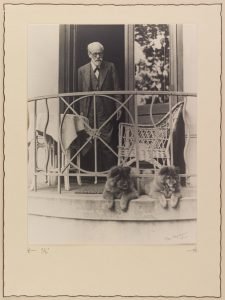This post is part of our ‘ask any question‘ series for psychology students and teachers. Do you or one of your students have a question about Freud or psychoanalysis? Send them in and we will do our best to answer them!

Sigmund Freud with his dogs, 1933.
The simple answer is: yes!
Many of our visitors find it surprising that when the 82-year-old Sigmund Freud arrived in England as a refugee from the Nazis in 1938, he was accompanied not just by his immediate family but also by his beloved Chow, Lun, who had to spend the following six months in quarantine in West London.
Little is known about Freud’s apparent lack of enthusiasm for cats, but his love for dogs was evident.
He was known to have owned dogs since the 1920s, being very affectionate with and deeply fascinated by them.
In a letter to his friend Marie Bonaparte he wrote:
“Dogs love their friends and bite their enemies, quite unlike people, who are incapable of pure love and always have to mix love and hate in their object relations.”
Freud would become so inseparable from his companions that many of his patients would meet them in his consulting room. Rumour had it that the father of psychoanalysis didn’t need to keep track of time during sessions, as his dogs would simply get up and leave the room when the hour was up.
On several of his birthdays his daughter Anna or son Martin wrote short congratulatory poems with wishes ‘from the dogs’ – currently on display in the museum.
In 1938, in the midst of the nerve-wracking emigration arrangements and waiting for the exit visas to arrive, Freud and Anna found refuge in a new creative venture: they were translating Marie Bonaparte’s book Topsy: The Story of a Golden Haired Chow (1936) about a dog who, like Freud himself at the time, suffered from cancer. Freud greatly appreciated the book and had praised it to the author a few years earlier in a moving and revealing letter:
“…It really explains why one can love an animal […] with such extraordinary intensity: affection without ambivalence, the simplicity of a life free from the almost unbearable conflicts of civilisation, the beauty of an existence complete in itself; and yet, despite all divergence in the organic development, that feeling of an intimate affinity, of an undisputed solidarity.
Often when stroking Jo-Fi I have caught myself humming a melody which, unmusical as I am, I can’t help recognising as the aria from Don Giovanni: “A bond of friendship Unites us both…”
A visit to the Freud Museum can help your students sort Freud-fact from Freud-fiction.
Facilitated group visits are a great way to get a deeper insight into Sigmund Freud, Anna Freud and psychoanalysis.
The Freud Museum is very popular with A-level groups, particularly those studying psychology or religious studies.




Comments
Simply thanks to you all for share this.